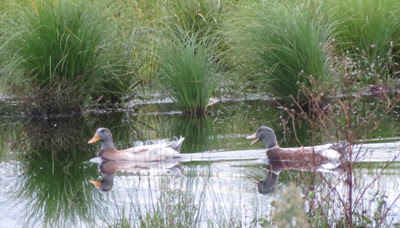Welcome to the Midnight Collective Broadsheet 138
Actively
supporting NZ’s endangered wetland birds
This pair of what
looked like domestic visitors, turned up at the dune lake a couple of weeks ago
and have decided to stay put. We were at a loss to identify them so turned to experts in Whanganui, Ridgway Lythgoe, Colin Ogle and Peter Frost for help.
Here, with thanks, is Peter’s analysis…
This is a
domestic duck, obviously with a predominance of mallard genes. (The other
source of genes in domestic ducks is muscovy, the genes of which are clearly
not present here.)
Domestic ducks
of this kind are usually some variant of the ‘subspecies’ Anas platyrhynchos
domesticus, although this subspecies is obviously not a natural one but has
been applied to domestic birds, given the many hundreds of years of
domestication of mallards. Ducks of this lineage have been further selectively
bred to produce breeds such as the Indian runner duck, Campbell, Aylesbury
(which are all white, as is the Pekin duck), Abacot Ranger and many more
(see https://poultrykeeper.com/duck-breeds/). These breeds in turn, if they go feral, which
they often do, can interbreed; some may even breed with wild-type mallards.
 |
| Male domesticus |
My guess is
that this duck is some mix either of Abacot Ranger or Silver Appleyard (or even
a hybrid of both) and perhaps Indian runner (the male’s somewhat upright stance
suggests that its legs are situated further back on the pelvic girdle than the
usual mallard, a feature that is characteristic of runner ducks and which is
why they can run rather than waddle).
There
really isn’t much more to say, except that there are many of these domestic
variants around, especially close to human habitation.
Peter Frost
Science
Support Service -Project development; research; training;
scientific writing, editing and proofreading
You can contact Peter at
There has been a
dramatic local decline in bird populations over the last few weeks and we are hoping
this is due to normal seasonal migration, and not the duck shooting season which
opened at the start of the month. Previous to the Expressway development we would
usually have up to 20 mallards in resident through winter but this year we are
reduced to these two, caught in siesta.
 |
| Mallard pair |
This coincides
with a notable decline in ducks seen further up the Wharemauku in the town centre(where they can be fed by the public),
though this could still be the result of the disturbance caused by the Expressway construction.
It has been good
however to see shovellers and grey teal finding a home here.
 |
| Male Australasian shoveller |
 |
| Female grey teal |
Two male
shovellers have been regularly sighted but only one female, and this gave rise to a forelorn attempt by the lone male to attract a young female grey teal
away from her mate.
 |
| Grey teal pair and male shoveller |
He got short shift from her…
 |
| That's close enough (she scootled away back to her mate) |
One thing we
haven’t seen before at this time of year are these Pied Stilts.
 |
| Pied stilts |
They usually migrate (though they don’t leave this country) but these three don’t appear to be
doing that and our guess is that they are the three youngsters we followed
through summer. The adults may not have gone far, because there is still a
colony at Pauatahanui about 20 km south as the pied stilt flies.
 |
| Pied stilts |
With much more
room to breed now, we are looking forward to an increase in the local
population of these delightful birds
 |
| Spot the intruder |
Finally an
addition to our spot-the-intruder competition… Winter starts tomorrow and the wet weather hasn't let up since last spring; but the little indigenous guy in this
foto continues to survive and thrive.
Track we were
listening to today… we are going back, way back into the Kiwi underground of
the sixties where the La De Da’s went head to head with the Rolling Stones,
to send out this airy roiling classic… How Is The Air Up There.
The first time that I saw you
Said you'd hope I never change
Your folks took one look at me
And they sure acted strange
This post goes out
to art aficionado and local confederate LK (she knows who she is!) currently gallivanting
round Brexit country and out into the EU – time to get home and get those broad beans back
in the ground…Spring is on the way.






